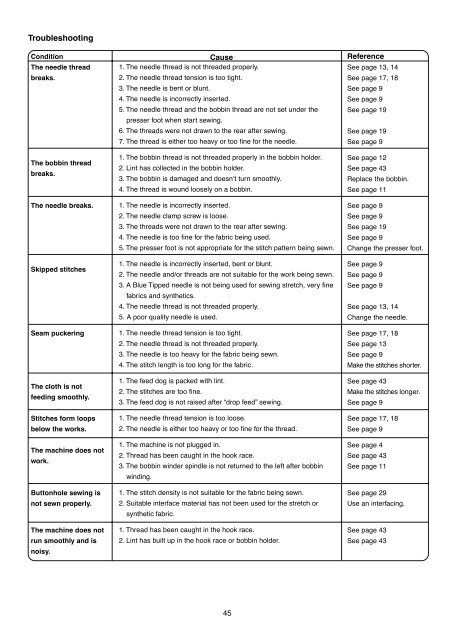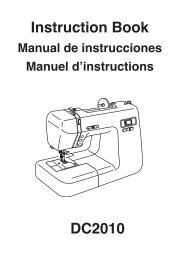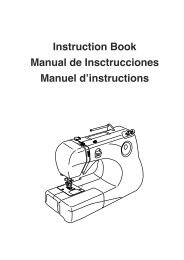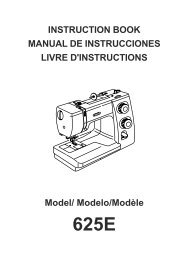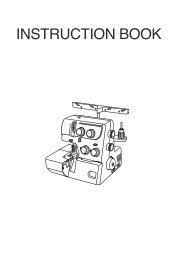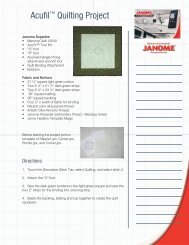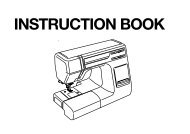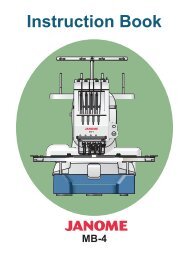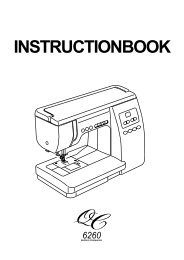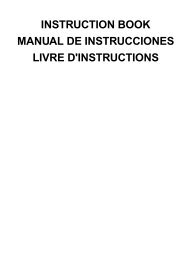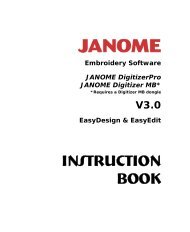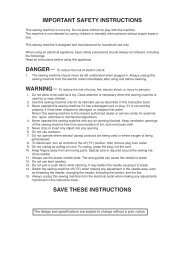INSTRUCTION BOOK - Janome
INSTRUCTION BOOK - Janome
INSTRUCTION BOOK - Janome
Create successful ePaper yourself
Turn your PDF publications into a flip-book with our unique Google optimized e-Paper software.
Troubleshooting<br />
Condition<br />
The needle thread<br />
breaks.<br />
The bobbin thread<br />
breaks.<br />
The needle breaks.<br />
Skipped stitches<br />
Seam puckering<br />
The cloth is not<br />
feeding smoothly.<br />
Stitches form loops<br />
below the works.<br />
The machine does not<br />
work.<br />
Buttonhole sewing is<br />
not sewn properly.<br />
The machine does not<br />
run smoothly and is<br />
noisy.<br />
Cause<br />
1. The needle thread is not threaded properly.<br />
2. The needle thread tension is too tight.<br />
3. The needle is bent or blunt.<br />
4. The needle is incorrectly inserted.<br />
5. The needle thread and the bobbin thread are not set under the<br />
presser foot when start sewing.<br />
6. The threads were not drawn to the rear after sewing.<br />
7. The thread is either too heavy or too fine for the needle.<br />
1. The bobbin thread is not threaded properly in the bobbin holder.<br />
2. Lint has collected in the bobbin holder.<br />
3. The bobbin is damaged and doesn’t turn smoothly.<br />
4. The thread is wound loosely on a bobbin.<br />
1. The needle is incorrectly inserted.<br />
2. The needle clamp screw is loose.<br />
3. The threads were not drawn to the rear after sewing.<br />
4. The needle is too fine for the fabric being used.<br />
5. The presser foot is not appropriate for the stitch pattern being sewn.<br />
1. The needle is incorrectly inserted, bent or blunt.<br />
2. The needle and/or threads are not suitable for the work being sewn.<br />
3. A Blue Tipped needle is not being used for sewing stretch, very fine<br />
fabrics and synthetics.<br />
4. The needle thread is not threaded properly.<br />
5. A poor quality needle is used.<br />
1. The needle thread tension is too tight.<br />
2. The needle thread is not threaded properly.<br />
3. The needle is too heavy for the fabric being sewn.<br />
4. The stitch length is too long for the fabric.<br />
1. The feed dog is packed with lint.<br />
2. The stitches are too fine.<br />
3. The feed dog is not raised after “drop feed” sewing.<br />
1. The needle thread tension is too loose.<br />
2. The needle is either too heavy or too fine for the thread.<br />
1. The machine is not plugged in.<br />
2. Thread has been caught in the hook race.<br />
3. The bobbin winder spindle is not returned to the left after bobbin<br />
winding.<br />
1. The stitch density is not suitable for the fabric being sewn.<br />
2. Suitable interface material has not been used for the stretch or<br />
synthetic fabric.<br />
1. Thread has been caught in the hook race.<br />
2. Lint has built up in the hook race or bobbin holder.<br />
45<br />
Reference<br />
See page 13, 14<br />
See page 17, 18<br />
See page 9<br />
See page 9<br />
See page 19<br />
See page 19<br />
See page 9<br />
See page 12<br />
See page 43<br />
Replace the bobbin.<br />
See page 11<br />
See page 9<br />
See page 9<br />
See page 19<br />
See page 9<br />
Change the presser foot.<br />
See page 9<br />
See page 9<br />
See page 9<br />
See page 13, 14<br />
Change the needle.<br />
See page 17, 18<br />
See page 13<br />
See page 9<br />
Make the stitches shorter.<br />
See page 43<br />
Make the stitches longer.<br />
See page 9<br />
See page 17, 18<br />
See page 9<br />
See page 4<br />
See page 43<br />
See page 11<br />
See page 29<br />
Use an interfacing.<br />
See page 43<br />
See page 43


